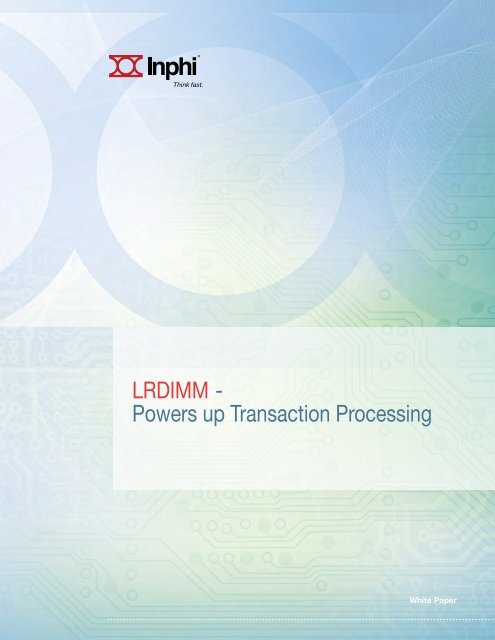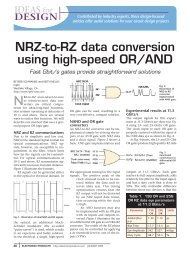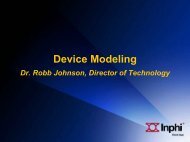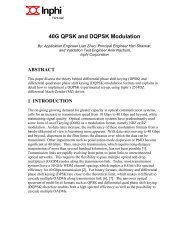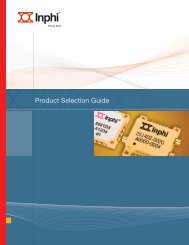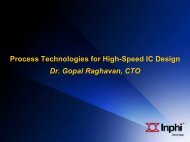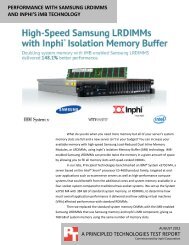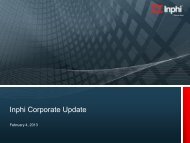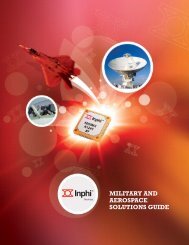LRDIMM - Powers up Transaction Processing - Inphi Corporation
LRDIMM - Powers up Transaction Processing - Inphi Corporation
LRDIMM - Powers up Transaction Processing - Inphi Corporation
- No tags were found...
You also want an ePaper? Increase the reach of your titles
YUMPU automatically turns print PDFs into web optimized ePapers that Google loves.
<strong>LRDIMM</strong> -<br />
<strong>Powers</strong> <strong>up</strong> <strong>Transaction</strong> <strong>Processing</strong><br />
White Paper
The latest innovation in server memory technology is the Load Reduced DIMM,<br />
or <strong>LRDIMM</strong>. By isolating multiple DRAM ranks behind a single memory buffer, the<br />
<strong>LRDIMM</strong> enables higher capacity and higher speed main memory in high-performance<br />
servers, providing a significant increase in online transaction processing benchmark<br />
performance.<br />
Recently, IBM published TPC-E benchmark results showing a significant performance<br />
increase in a server configured with <strong>LRDIMM</strong> memory compared to a server configured<br />
with RDIMM memory. The <strong>LRDIMM</strong> modules used in the test featured the iMB02-<br />
GS02A Isolation Memory Buffer (iMB) from <strong>Inphi</strong> <strong>Corporation</strong>. This paper provides an<br />
overview of the TPC-E benchmark and its implications to on-line transaction processing<br />
(OLTP), a summary of the results achieved by IBM, and a technical explanation of the<br />
speed and capacity advantages of <strong>LRDIMM</strong>.<br />
The TPC-E Benchmark<br />
TPC Benchmark E (TPC-E) is maintained by the <strong>Transaction</strong> <strong>Processing</strong> Performance Council (TPC), with results<br />
posted publicly on the TPC website at www.tpc.org. The TPC-E benchmark was created in 2007 to emulate the<br />
large, complex databases and high online transaction processing (OLTP) workloads a brokerage firm faces in daily<br />
operations. Results are independently audited and must be accompanied by a detailed disclosure report for full<br />
transparency and accurate comparisons with other published results.<br />
The TPC-E benchmark measures system performance on a simplified model of a brokerage firm, measured<br />
in transactions per second between customers, the market and the brokerage firm, as shown in Figure 1. Ten<br />
different types of transactions are included, resulting in <strong>up</strong>dates and accesses to four different types of databases.<br />
Customers initiate transactions to buy or sell securities, research the market, or inquire about their accounts. The<br />
brokerage firm executes orders in the market and <strong>up</strong>dates customer accounts.<br />
Figure 1 – TPC-E Brokerage Firm Model<br />
<strong>LRDIMM</strong> <strong>Powers</strong> <strong>up</strong> <strong>Transaction</strong> <strong>Processing</strong> 2
The TPC-E benchmark driver generates the transactions, submits them to the system under test, and measures the<br />
rate of transaction completion. The four separate databases for customer, brokerage, market, and dimension data (such<br />
as ZIP codes) are scalable to stress high capacity server systems, and created with realistic data based on information<br />
from the U.S. Census Bureau and the New York Stock Exchange. For every 1,000 customers modeled there are 685<br />
securities from 500 companies, belonging to 102 industries in 12 different sectors. Customers are separated into three<br />
tiers, with each tier having a different average number of accounts and a different average trading frequency. Trades are<br />
divided into five different transaction types, including Market-Buy, Market-Sell, Limit-Buy, Limit-Sell and Stop-Loss.<br />
The end result is a realistic and scalable benchmark for comparing online transaction processing capabilities of various<br />
systems, with results highly dependent on system memory capacity and memory access rates. <strong>LRDIMM</strong>-enabled<br />
systems can improve both memory capacity and access rates, although the IBM TPC-E results quoted here utilize<br />
systems with equal DRAM capacities. The improvement in transactions per second (tpsE) achieved here reflects primarily<br />
the speed advantage provided by <strong>LRDIMM</strong> over traditional RDIMM memory.<br />
IBM TPC-E Results Summary<br />
A summary of the TPC-E results published by IBM is provided in Table 1. The RDIMM-equipped system tested in 2011<br />
achieved a tpsE rating of 1,560.70 transactions per second. The <strong>LRDIMM</strong>-equipped system tested in 2012 achieved<br />
a tpsE rating of 1,863.23 transactions per second, an increase of 19.38 percent, as shown in Figure 2. Both systems<br />
were equipped with 512GB of DDR3 DRAM, and the initial database size in each case was at least twelve times larger<br />
than the available main memory.<br />
While some portion of the performance improvement could be attributed to differences between the servers and CPUs<br />
used in each test, for memory-intensive applications such as the TPC-E benchmark the most important factor is memory<br />
access speed. With the 16GB DDR3 RDIMM modules, the RDIMM system’s memory bus was limited to 800 MT/s or<br />
1066 MT/s operation. The <strong>LRDIMM</strong> system utilized 32GB DDR3 <strong>LRDIMM</strong> modules, capable of running at 1333 MT/s,<br />
even at 1.35V. Though not all attributed to the memory subsystem, this increase in operating speed is responsible for<br />
improvement in the transactions per second while running the TPC-E benchmark.<br />
Table 1: TPC-E Results, <strong>LRDIMM</strong> based system vs. RDIMM based system<br />
Figure 2: tpsE Metric, <strong>LRDIMM</strong> vs. RDIMM<br />
<strong>LRDIMM</strong> <strong>Powers</strong> <strong>up</strong> <strong>Transaction</strong> <strong>Processing</strong> 3
The results discussed above reflect the speed advantage of <strong>LRDIMM</strong> over RDIMM for systems with equal amounts of<br />
DRAM installed, 512GB in this case, with <strong>LRDIMM</strong> running at 1333 MT/s compared to 1066 MT/s for RDIMM. For<br />
benchmarks like TPC-E, and real-world applications where the database size is significantly larger than the installed<br />
memory, <strong>LRDIMM</strong> would provide an additional performance advantage by allowing a higher amount of memory to be<br />
installed at the same operational frequency, reducing the required hard disk access time by resolving more database<br />
queries in DRAM.<br />
The TPC-E benchmark also rates the server systems tested based on cost (in US dollars) per transaction per second,<br />
or $/tpsE. By this metric, the <strong>LRDIMM</strong> system fared very well, ranking as the 8th lowest in $/tpsE out of 55 different<br />
systems reported on the TPC website even using IBM’s list price of $4,599 at the time of the test. However, the price<br />
of 32GB <strong>LRDIMM</strong> is coming down quickly. For example, IBM is now listing the 32GB <strong>LRDIMM</strong> for $2,099. Using this<br />
price, the $/tpsE is approximately $196 thereby significantly improving the cost efficiency of the overall server as shown<br />
in Table 2.<br />
<strong>LRDIMM</strong> Overview<br />
Table 2: USD $/tpsE<br />
The <strong>LRDIMM</strong> enables the performance improvement observed in these TPC-E benchmark results by isolating multiple<br />
ranks of DRAM behind a memory buffer such as <strong>Inphi</strong>’s iMB02-GS02A, as shown in Figure 3. In a traditional RDIMM<br />
module the data bus signals from the host connect through the DIMM connector directly to the DRAM, placing multiple<br />
DRAM loads on every data bit for multi-rank modules, including the DRAM loads from adjacent RDIMM modules in the<br />
same memory channel. If four-rank RDIMMs are installed in a channel with two DIMM slots, each data bit would see<br />
eight electrical loads, limiting signal integrity and system performance at higher speeds.<br />
In an <strong>LRDIMM</strong> module the data bus signals from the host connect through the DIMM connector to the memory buffer,<br />
which re-drives the data bus to the DRAM on the front and back sides of the module. The memory buffer thus isolates<br />
the DRAM from the host, and from the DRAM on any adjacent <strong>LRDIMM</strong> module on the same memory channel. For<br />
a system with two DIMM slots per channel, the memory controller would see two electrical loads (the memory buffer<br />
on each <strong>LRDIMM</strong>), compared to eight electrical loads in an RDIMM system (the four ranks of DRAM on each RDIMM).<br />
This load reduction enables the memory data bus to operate at higher speeds with no loss of signal integrity, providing<br />
system performance benefits in memory intensive applications such as online transaction processing.<br />
The <strong>LRDIMM</strong>’s memory buffer also buffers the command, address and control signals from the memory controller,<br />
similar to the way that the register on an RDIMM buffers those signals. In systems with three DIMM slots per channel<br />
the memory buffer enables additional increases in memory capacity, overcoming the traditional limit of eight chip selects<br />
per channel through a feature called Rank Multiplication, allowing the use of three four-rank <strong>LRDIMM</strong> modules in a single<br />
channel. Eight-rank <strong>LRDIMM</strong>s are also possible, with several module vendors having announced 64GB 8Rx4 <strong>LRDIMM</strong>s.<br />
Figure 3: <strong>LRDIMM</strong><br />
<strong>LRDIMM</strong> <strong>Powers</strong> <strong>up</strong> <strong>Transaction</strong> <strong>Processing</strong> 4
Conclusion<br />
DDR3 <strong>LRDIMM</strong> memory provides significant performance improvement over traditional DDR3 RDIMM memory by<br />
enabling higher memory access speeds for a given memory capacity, or by allowing higher memory capacities at a<br />
given memory speed. IBM has published TPC-E benchmark results confirming this dramatic performance improvement<br />
with <strong>LRDIMM</strong> using <strong>Inphi</strong>’s iMB02-GS02A Isolation Memory Buffer. The published results show the cost effectiveness<br />
of <strong>LRDIMM</strong> as a commercially available DRAM solution, one which will become even more cost effective over time. The<br />
TPC-E benchmark models real world brokerage house functions with large customer databases, showing the promise of<br />
<strong>LRDIMM</strong> in powering <strong>up</strong> online transaction processing and all time-critical, memory-intensive processing tasks.<br />
Sources<br />
TPC Benchmark E Full Disclosure Report for IBM® System x® 3650 M4 using Microsoft® SQL Server 2012<br />
Enterprise Edition and Microsoft Windows® Server 2008 R2 Enterprise Edition SP1, March 6, 2012, published online at<br />
http://www.tpc.org/tpce/results/tpce_result_detail.aspid=112030601<br />
TPC Benchmark E Full Disclosure Report for IBM® System x® 3690 X5 using Microsoft® SQL Server 2008 R2<br />
Enterprise Edition and Microsoft Windows® Server 2008 R2 Enterprise Edition, May 27, 2011, published online at<br />
http://www.tpc.org/tpce/results/tpce_result_detail.aspid=111052701<br />
All TPC-E results are posted on the website of the <strong>Transaction</strong> <strong>Processing</strong> Performance Council at<br />
http://www.tpc.org/tpce/results/tpce_results.asp<br />
Overview of TPC-E, published online at http://www.tpc.org/tpce/default.asp<br />
Key Benchmarks for Measuring <strong>Transaction</strong> <strong>Processing</strong> Performance, published online at<br />
http://searchdatamanagement.techtarget.com/feature/Key-benchmarks-for-measuring-transaction-processing-performance<br />
10/26/2012<br />
<strong>Inphi</strong> Headquarters<br />
3945 Freedom Circle<br />
Suite 1100<br />
Santa Clara, CA 95054<br />
Phone: (408) 217-7300<br />
<strong>Inphi</strong> Southern California<br />
112 S. Lakeview Canyon<br />
Rd. Suite 100<br />
Westlake Village, CA 91362<br />
Phone: (805) 719-2300<br />
Web: www.inphi.com<br />
© 2012 <strong>Inphi</strong> <strong>Corporation</strong>. All rights reserved. <strong>Inphi</strong>, the <strong>Inphi</strong> logo, Think fast, and ExacTik are registered<br />
trademarks of <strong>Inphi</strong> <strong>Corporation</strong>. iMB is a trademark of <strong>Inphi</strong> <strong>Corporation</strong>.<br />
5


